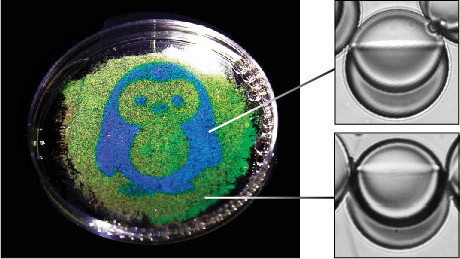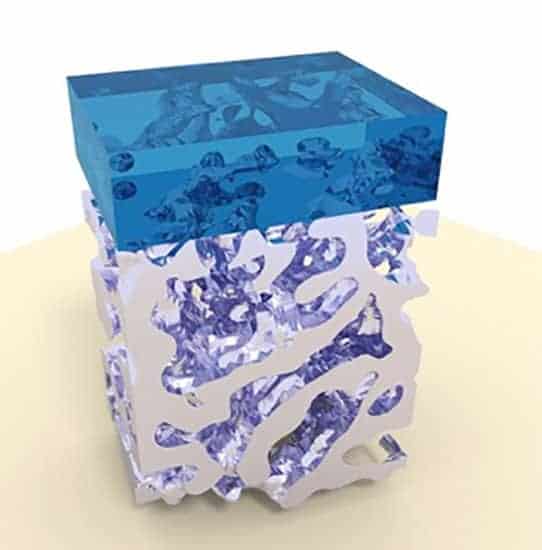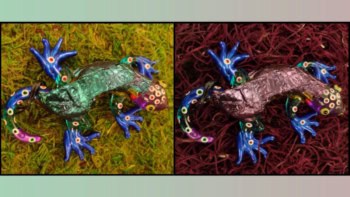
A new technique for creating iridescence in droplets has been developed by Lauren Zarzar and colleagues at Pennsylvania State University and the Massachusetts Institute of Technology. The team discovered the technique accidentally and believes that it could have a wide range of applications, from paints to sensors.
The familiar iridescent colours in films of oil or bubbles of soap are caused by interference between reflections from the front and back of the film. A similar effect occurs a result of diffraction from the ridges on a CD or the scales on a butterfly’s wing. All these effects require features on the scale of the wavelength of visible light, which is approximately 400-700 nm.
Zarazar’s team, however, observed iridescent colours in hybrid droplets that were 100 micron in diameter and made from the hydrocarbon heptane and the fluorocarbon perfluorohexane. The droplets had “Janus” morphologies – each was essentially half a heptane droplet stuck to half a perfluorohexane droplet (see figure).
Seeking tuneable lenses
The team was interested in these droplets because heptane and perfluorohexane is a combination that breaks the usual correlation between refractive index and density. Denser materials normally have higher indices of refraction, but as Zarzar explains: “We were intentionally trying to flip it the other way. The fluorocarbons tend to be very dense but also very low refractive index.” The researchers’ intention was that the droplets would behave as miniature, tuneable lenses.
They were amazed, however, to find that the droplets reflected brilliant colours that varied with viewing angle when they were illuminated with far-field white light. “When we see this iridescence, I’m immediately thinking we have something that’s giving us periodicity on the wavelength of light,” says Zarzar, “Because that’s what would lead to interference and structural colour.”
However, they could find no evidence for such periodicity. Moreover, when they looked at the droplets under a microscope, many features they observed made no sense from the point of view of traditional diffractive optics. For example, each droplet seemed to reflect a specific colour of light when viewed from a particular angle, irrespective of the position of other droplets.
“It didn’t matter whether the droplets were close packed or randomly oriented, so it didn’t come from some kind of diffraction grating happening between the droplets or something like that,” says Zarzar.
Counterintuitive effect
An emulsion containing droplets of one size reflected pure colours that changed with the viewing angle. Droplets of different sizes reflected multiple colours at any given angle, however, with such an emulsion producing white light. “There was something happening in a single, 100 micron scale droplet that was somehow causing this effect, and it wasn’t intuitive that you could get interference from something that large that didn’t have any periodicity within it, says Zarzar.
After much head scratching, the researchers realized the phenomenon could arise by total internal reflection. Because it has a lower density, the heptane nestles within the perfluorohexane, with a concave interface between the two liquids (see figure). When light hits this interface at an angle, classical ray optics dictates that, as the perfluorohexane has a lower refractive index, it should refract away from the normal. If the angle of incidence is too great, however, the light cannot escape and undergoes total internal reflection.

Robust structural colour is inspired by a tropical bird
“The light may bounce several times around that concave interface depending on the initial angle of incidence, and rays that have bounced different numbers have different path lengths and end up out of phase,” explains Zarzar. “That’s what gives rise to the interference. Our collaborators at MIT have a model that can use the refractive index contrast, the geometry of the interface and the incoming angle of the light to predict the pattern of iridescence that you generate.”
The researchers also showed that, by incorporating an ultraviolet-responsive surfactant into the droplets, they could use UV light to change the interfacial properties of the liquids and thereby control the colours of visible light reflected by the droplets. “We have several publications where we sensitize these biphasic droplets to things like temperature and pH,” says Zarzar. “You could use the colour as a readout of the morphology of the emulsion, which could be used for sensing.” In the nearer term, they hope to produce iridescent paints that do not require nanoscale structures.
Commenting on the team’s discovery, David Weitz of Harvard University says, “I give them a lot of credit for recognizing it and figuring it out. I don’t see that structural colour has ever really had a huge impact technologically, but maybe this will have more of a chance because here you don’t have to worry about precisely controlled thicknesses – I don’t know.”
The effect is described in Nature.



